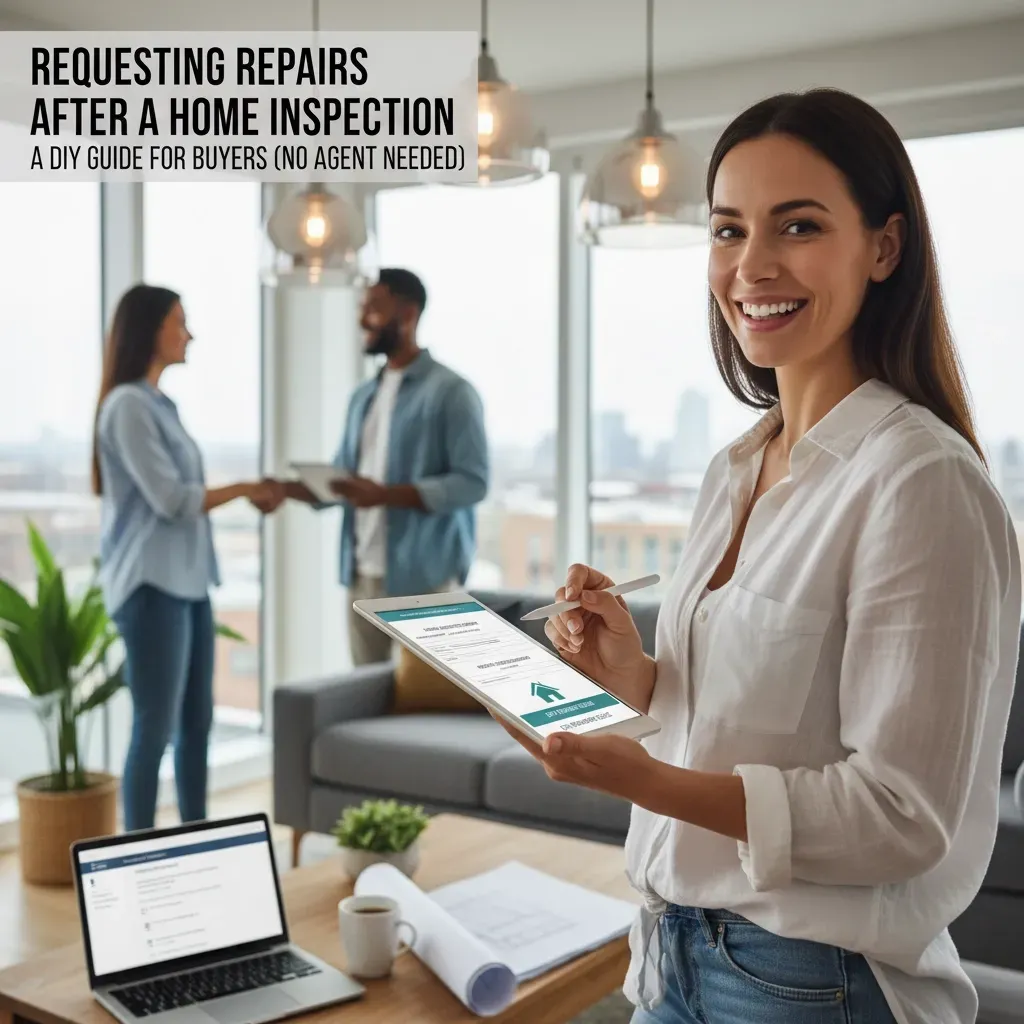
Submitting a request for repairs after Home Inspection
Requesting Repairs After a Home Inspection: A DIY Guide for Buyers (No Agent Needed)
So you've had your home inspection done, and now you're staring at a multi-page report that reads like a horror novel. Leaky roof, faulty wiring, questionable plumbing – suddenly your dream home feels more like a money pit. Here's the thing: you don't need a real estate agent to navigate the repair request process successfully. With the right approach, you can protect your investment and get the seller to address legitimate concerns.
This guide will walk you through every step of requesting repairs after your home inspection, from analyzing that intimidating report to crafting professional requests that actually get results.
Understanding Your Position in Repair Negotiations
Before diving into the process, let's set realistic expectations. Sellers are never legally required to make any repairs after a home inspection. They have every right to refuse your requests entirely. However, most sellers will address reasonable concerns to keep the sale moving forward – especially when they know other potential buyers would likely flag the same issues.
Your leverage depends on several factors: the local market conditions, how long the property has been listed, and whether the seller is motivated by timeline or price. Use this knowledge to your advantage when crafting your requests.

Step 1: Decode Your Inspection Report Like a Pro
Start by reading through your entire inspection report, but don't panic at every minor issue. Inspectors are thorough – sometimes overly so. Focus on the summary section first, which typically highlights the most significant problems.
Create three categories as you review:
Must-Fix Issues: Safety hazards, structural problems, or major system failures that could cost thousands to repair later.
Should-Fix Issues: Problems that affect the home's functionality or value but aren't immediate safety concerns.
Nice-to-Fix Issues: Cosmetic problems or minor maintenance items you can easily handle yourself.
Only the first two categories belong in your repair request. Remember, you're buying a used home, not a new construction property.
What Repairs Actually Make Sense to Request
Focus your requests on significant structural, mechanical, or environmental defects that represent substantial problems any buyer would want addressed. Here's what typically qualifies as reasonable:
Safety and Health Concerns:
Termites or wood-destroying insects
Wildlife infestations in attics or crawl spaces
Mold problems or moisture issues
Elevated radon levels above EPA recommendations
Lead paint hazards
Major electrical defects creating safety risks
Structural and System Issues:
Leaking roofs or major structural damage
Significant plumbing problems affecting home use
HVAC systems that don't function properly
Well problems including water pressure or quality issues
Building code violations that require permits to fix
Avoid requesting repairs for cosmetic issues, normal wear and tear, or problems that cost less than $500 to fix. These requests make you look unreasonable and can derail negotiations.

Step 2: Create Your Formal Repair Request
Your repair request form serves as official documentation and legal protection. This document should clearly notify the seller of material defects discovered during inspection and demand they fix, replace, or provide monetary compensation for specific issues.
Essential Elements of Your Request:
Detailed Problem Descriptions: Don't just write "fix electrical issues." Instead, specify "Replace outdated electrical panel in basement and install GFCI outlets in all bathrooms as required by current electrical codes."
Qualified Professional Requirements: For major systems, specify that work must be performed by licensed contractors. This protects you from shoddy DIY repairs that could cause problems later.
Completion Timeline: Include deadlines for when repairs must be finished, typically before closing or within a specified timeframe.
Documentation Requirements: Request receipts, warranties, and certificates of completion for all work performed.
Step 3: Master the Art of Repair Negotiation
For each issue in your request, you can pursue three different approaches:
Direct Repair: Ask the seller to fix the problem using qualified professionals. This works best for items where you want to ensure proper completion.
Replacement: Request complete replacement rather than repairs for items near the end of their useful life, like old HVAC systems or water heaters.
Monetary Credit: Negotiate a dollar amount credit at closing instead of actual repairs. This approach gives you control over the quality of work but requires getting accurate repair estimates beforehand.
Consider your priorities carefully. If you're concerned about whether sellers will complete repairs adequately, monetary credits often provide better outcomes since you can hire your own contractors after closing.

Step 4: Professional Communication Strategies
How you present your request matters as much as what you're requesting. Professional communication increases your chances of success and maintains goodwill throughout the process.
Use Formal Documentation: Submit your requests using a standard Request for Repairs form or create a professional document with clear headers and organization.
Provide Context: Include relevant portions of the inspection report to support your requests. Sellers respond better when they understand the inspector's concerns.
Offer Flexibility: When possible, give sellers options. For example, "Replace the water heater OR provide a $1,200 credit at closing."
Set Clear Deadlines: Specify when you need a response and when repairs must be completed. This prevents delays that could jeopardize your financing or closing timeline.
Common Pitfalls That Kill Deals
Avoid these mistakes that can torpedo your negotiation:
The Kitchen Sink Approach: Requesting repairs for every minor issue mentioned in the inspection report makes you look unreasonable and gives sellers an excuse to reject everything.
Vague Language: Writing "fix plumbing problems" instead of specifying exactly what needs attention creates confusion and potential disputes.
Unrealistic Timelines: Demanding complex repairs be completed in just a few days isn't practical and signals inexperience.
Emotional Language: Keep your tone professional and factual. Avoid phrases like "this is unacceptable" or "we're extremely concerned."
Ignoring Market Conditions: In hot markets with multiple offers, extensive repair requests might prompt sellers to move to backup offers.

Handling Seller Responses
Sellers typically respond in one of three ways: accept all requests, reject everything, or propose counteroffers. Each scenario requires a different strategy.
If They Accept: Great! Ensure you receive proper documentation and follow up to confirm completion before closing.
If They Reject: Consider which items are true deal-breakers versus nice-to-haves. You might negotiate monetary credits for the most critical issues.
If They Counter: Evaluate their proposals carefully. Sellers might offer to fix some items while providing credits for others, or suggest different solutions than you originally requested.
Remember that you have options too. You can accept their counter, propose your own counter-offer, or exercise your right to walk away if the issues are too significant.
Protecting Yourself Throughout the Process
Document everything. Keep copies of your repair request, the seller's response, receipts for completed work, and any warranty information. Take photos of problems before and after repairs when possible.
If sellers complete repairs before closing, consider having critical items re-inspected by your original inspector or a specialist. This small investment can prevent major headaches later.
Your Next Move
Successfully requesting repairs without an agent isn't just about saving money – it's about taking control of your home buying process and ensuring you get the property you're paying for. By following these steps, you'll approach repair negotiations with confidence and professionalism that gets results.
Ready to take control of your entire home buying process? At Unbeatable Loans, we help buyers like you cut out unnecessary costs while securing the financing you need. When you eliminate buyer's agent commissions, you can put more money toward the home itself or keep it in your pocket.
Unbeatable Loans – You found the home. You just need an Unbeatable loan.
